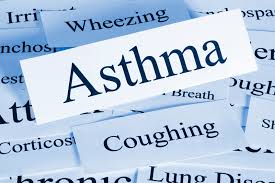Asthma-Conventional, Nutritional,Herbal and Lifestyle Treatments
What is Asthma?
- Asthma is a lung disease which causes airways obstruction
- It relates to an overreaction of the body’s own immune system usually caused by exposure to an allergen that the body perceives as foreign and dangerous
- During an asthma attack, muscles surrounding the bronchi spasm and constrict and impeded the outward passage of air (expiration); asthma suffers typically describe this as “starving for air"
- An asthma attack can last for a few minutes to several hours

Causes of Asthma
Causes/Aetiology:
- The spasms that characterize an acute asthma attack are not the cause of this disorder but is due to chronic inflammation and hypersensitivity of the airways to certain stimuli
- An attack can be triggered if a susceptible individual is exposed to an allergen
- Whatever the trigger factor may be, the bronchial tubes swell and become plugged with mucus
- Other trigger factors for an acute asthma attack include:
- Irritants
- Infection
- Stress
- Exercise
- Use of Aspirin, Ibuprofen , Naproxen or other NSAIDs
- Rapid changes in weather and humidity
- A hereditary link to asthma was found. Thus paving way for prevention of asthma rather than solely relying on treatment alone
Asthma: Signs and Symptoms
SIGNS/SYMPTOMS:
Typical Asthma attack symptoms:
- Coughing
- Wheezing
- A feeling of tightness in the chest
- Difficulty breathing

Asthma Types
Two forms of Asthma; Allergic and Non-Allergic (although the two often occur together)
Common Asthma provoking Allergens:
- Animal dander
- Cockroach allergens
- Pollens
- Mold
- Chemicals
- Drugs
- Dust mites
- Environmental pollutants
- Feathers
- Food additives (e.g. monosodium glutamate or sulfites like sodium metabisulfite)
- Seafood
- Dairy products
- Nuts
- Yeast-based foods
- Fumes
- Tobacco smoke and Other allergens
Factors that trigger non-allergic asthma attack:
- Adrenal disorders
- Anxiety
- Temperature changes
- Exercise
- Extremes of dryness or humidity
- Fear
- Laughing
- Low blood sugar
- Stress
- Respiratory infections
Cardiac Asthma :Is a condition causing same symptoms as other asthma types but is caused by heart failure
Intrinsic Asthma:
- is a less common form of the disease which generally appears during Adulthood and often associated with other respiratory diseases like bronchitis or sinusitis and usually appears during upper respiratory viral infections
- Suffers of this type are usually vulnerable to changes in weather, exercise, emotional stress and other factors related to inner feelings
Diagnosis
Clinical Tests/ Diagnostic Tests
- Asthma can be difficult to diagnose conclusively because its symptoms may resemble other diseases like emphysema, bronchitis, lower respiratory infections [1]
- To distinguish from other diseases, a physician can use blood tests, chest X-rays and spirometry (process that measures air breathed into and out of the lungs) [1]
- Bronchial asthma can lead to pulmonary emphysema if not treated properly but with prompt diagnosis and treatment, serious danger from asthma is preventable [1]

Conventional Treatments
TREATMENT
- 10% of Adults however remain symptomatic despite treatment with high-dose inhaled steroids and long acting beta-agonists [1]
Conventional :
(a) Relievers
- Relievers are fast acting medications that give rapid relief of asthma symptoms (wheeze, cough, shortness of breath). They are bronchodilators, which relax the muscle around the outside of the airway, which opens the airway.
- Everyone with asthma should have a reliever medication. There are two main categories of reliever medication: short-acting beta-agonists, and anticholinergics
- Possible adverse effects include:
- increased heart rate, sometimes felt as palpitations
- muscle tremor (shaking, especially in the hands), and/or
- slight feelings of anxiety or nervousness
These effects generally pass quickly, and are less likely to occur after the medication has been used a few times. They may occur when you take higher doses of the medication, such as during an asthma emergency.
(b) Preventers
- Preventer medications make the airways less sensitive, reduce redness and swelling and help to dry up mucus. Preventers need to be taken every day to reduce symptoms and asthma attacks, and it may take a few weeks before they reach their full effect. Your doctor will adjust your preventer medication to the lowest dose you need to keep your asthma well-controlled. Preventer medications are currently the drugs most likely to significantly improve your symptoms.
Inhaled corticosteroids?
These are anti-inflammatory medications, and are the most common of the preventer medications. They reduce inflammation in your airways, and can help airway cells repair and return to normal. These are not the same as steroids used for other diseases or for performance enhancement in sport, and are used at much smaller doses than when used in tablet form. Inhaled corticosteroids are commonly used in combination inhalers like Seretide or Symbicort, where they work along with a long-acting bronchodilator (also known as symptom controller).
If you have asthma symptoms occurring more than two or three times per week your doctor will prescribe preventer medication. In children, preventers are usually used only for those with more frequent symptoms and episodes of asthma.
Preventers come in different strengths, so it is helpful to know which strength your preventer is, not just how many puffs you take. The strength (number of micrograms) is marked on the medication, and some medications have slightly different colours to indicate different strengths.
The medications shown in the image below are different in strength and formulation, so don’t try to compare doses between different types of preventer medication. Your doctor will choose a medication that is right for you, based on strength, formulation, and the type of device in which it is available.
Are there any side effects?Possible adverse effects include:
- sore throat
- hoarse voice and/or
- oral thrush
These may be reduced by using a puffer and spacer, and rinsing your mouth and spitting after each dose.
Systemic adverse effects (caused through bloodstream absorption of the medication) are rare, but may include:
- skin bruising
- cataracts
- glaucoma
- adrenal suppression
- growth suppression and/or
- osteoporosis
(c) Symptom controllers
- Symptom controller medications (also called long-acting relievers/beta2-agonists) help relax the muscles around the airways. They should be taken twice daily, as they work for around 12 hours. They are only prescribed for people with asthma who are already taking regular inhaled corticosteroid preventer medication and still have asthma symptoms
- Note: They can actually worsen asthma if they are taken on their own without the regular corticosteroid preventer medication. To make it easier to take both of these medications, many people who use this medication take it in the form of a combination medication.
- Possible side effects may include shaky hands, fast heartbeat and/or headaches.
(d) Combination therapy
- Combination medications combine a preventer with a symptom controller in one device. They are usually prescribed when taking a preventer alone has not controlled asthma symptoms. They are taken once or twice each day, usually morning and night.
- Side effects: same as taking the medications separately. Possible local side effects include shaky hands, fast heartbeat, headaches, sore throat, hoarse voice and/or oral thrush.
- Systemic side effects (caused through bloodstream absorption of the medication) are rare, but may include cataracts, glaucoma, skin bruising, adrenal suppression, growth suppression and/or osteoporosis.
- Examples: Seretide, Symbicort
Natural treatments
The Natural Approach (with doses):
- Diet and Lifestyle [1]
- Eat a diet comprising primarily of fresh fruits and vegetables, nuts, oatmeal, brown rice and whole grains
- Diet should be relatively high in protein, low in carbohydrates and contain no sugar [1]
- Diet rich in wholegrains and fish shown to protect against asthma in children
- Consume soy as one component of it known as genistein is associated with better lung function in asthmatic patients
- Include Garlic and Onions in your diet (due to content of quercetin and mustard oils that inhibit and enzyme that aids in releasing inflammatory chemicals)
- Include “Green drinks” like Kyo-Green from Wakunaga taken three times daily before meals
- Take an enzyme complex or Avoid gas producing foods like beans, brassica (broccoli, cauliflower and cabbage) and large amounts of bran as gas can irritate an asthmatic condition by placing pressure on the diaphragm
- Do not eat ice cream or drink extremely cold liquids as these can shock bronchial tubes into spasms
- Eat light meals as heavy meals can cause shortness of breath
- Lose weight if one is overweight
- Avoid or minimise margarine as eating margarine in particular was associated with increased risk of developing asthma as an adult perhaps due to oleic acid
- Keep an ongoing list of things that trigger your asthma
- Practice stress relieving techniques
- Consider removing carpeting at least in the bedroom to help minimise dust mitews, germs and bacteria. Cover mattresses in plastic casings and washing sheets in hot water at least once a week can help too
- Nutrients & Herbs [1,3]; Adult doses provided (12years-17 years: ¾ Adult dose; 6 years to 12 years: ½ Adult dose; Children under 6 years old: 1/3 Adult dose); Essential ones are in Bold:
- Fish oil 1000mg twice daily (source of essential fatty acids needed for producing anti-inflammatory prostaglandins
- Vitamin B5 (Pantothenic acid) 50mg three times daily (Anti-stress)
- Selenium 100mcg daily (Low blood levels detected in asthmatics)
- Vitamin C with bioflavonoids 1500mg three times daily (Caution if history of kidney stones or hemochromatosis, avoid Vitamin C at this dosage); to protect lung tissue and prevent infection, increases air flow and fights inflammation
- Zinc lozenges 100mg daily maximum (can shorten attack or halt one before it becomes too severe)
- Very Important ones include:
- Betaine hydrochloride with pepsin; take as directed on label (combats malabsorption problems leading to leaky gut syndrome
- Coenzyme Q10; 100mg daily (counters histamine)
- Magnesium plus Calcium (use chelate or asporotate forms); 750mg Magnesium, 1500mg Calcium (may stop acute asthmatic episode by increasing vital capacity of lungs, dilates bronchial muscles
- Multivitamin mineral complex with selenium ; selenium 200mcg daily (40mcg if pregnant); Enhance immune function
- Vitamin B12 2000mcg daily (powerfully destroys free radicals)
- Vitamin E ; d-ALPHA TOCOPHEROL (antioxidant and helps with nervous support and healing of tissues): 15-1000MG DAILY
- Bee pollen may help (caution in hypersensitive individuals; start with few granules at a time and slowly work up to 2 teaspoons daily; strengthens immune system
Herbs [1,4]
- Lobelia extract (helpful during an asthma attack as it is a bronchial soothing muscle relaxant and expectorant); to be used under supervision of a healthcare professional as it is potentially toxic (Avoid in high blood pressure, heart disease, liver disease, kidney disease, seizure disorders or shortness of breath , pregnant and lactation); Dose: Dried herb: 0.2-0.6g three times daily
- Kelp: 2000mg-3000mg daily for 21 days then reduce to 1000-1500mg daily (For minerals in balanced amounts)
- Echinacea (Avoid in those allergic to ragweed, to be used for no longer than 3 months); Dose: 500mg capsule three times daily
- Licorice Root; Dose: Fluid Extract (1:1 dilution): 2-6mL daily (also helps with gastrointestinal and nerve health)
- Ginger root; Dose: 1 g daily (Dried ginger capsules)
- Elderberry; Dose: 1-2-1 teaspoon up to four times daily (Tincture)
- Slippery elm bark ; Dose: Fluid extract” 5mL three times daily
Licorice, Elderberry and Ginger open up the respiratory tract [1].
PROGNOSIS
Regular monitoring and adhering to the diet and lifestyle advice is imperative. Also a record of trigger factors is essential to ensure optimal health is maintained in asthmatic individuals. Overall prognosis is good so long as prompt diagnosis and treatment is provided.








